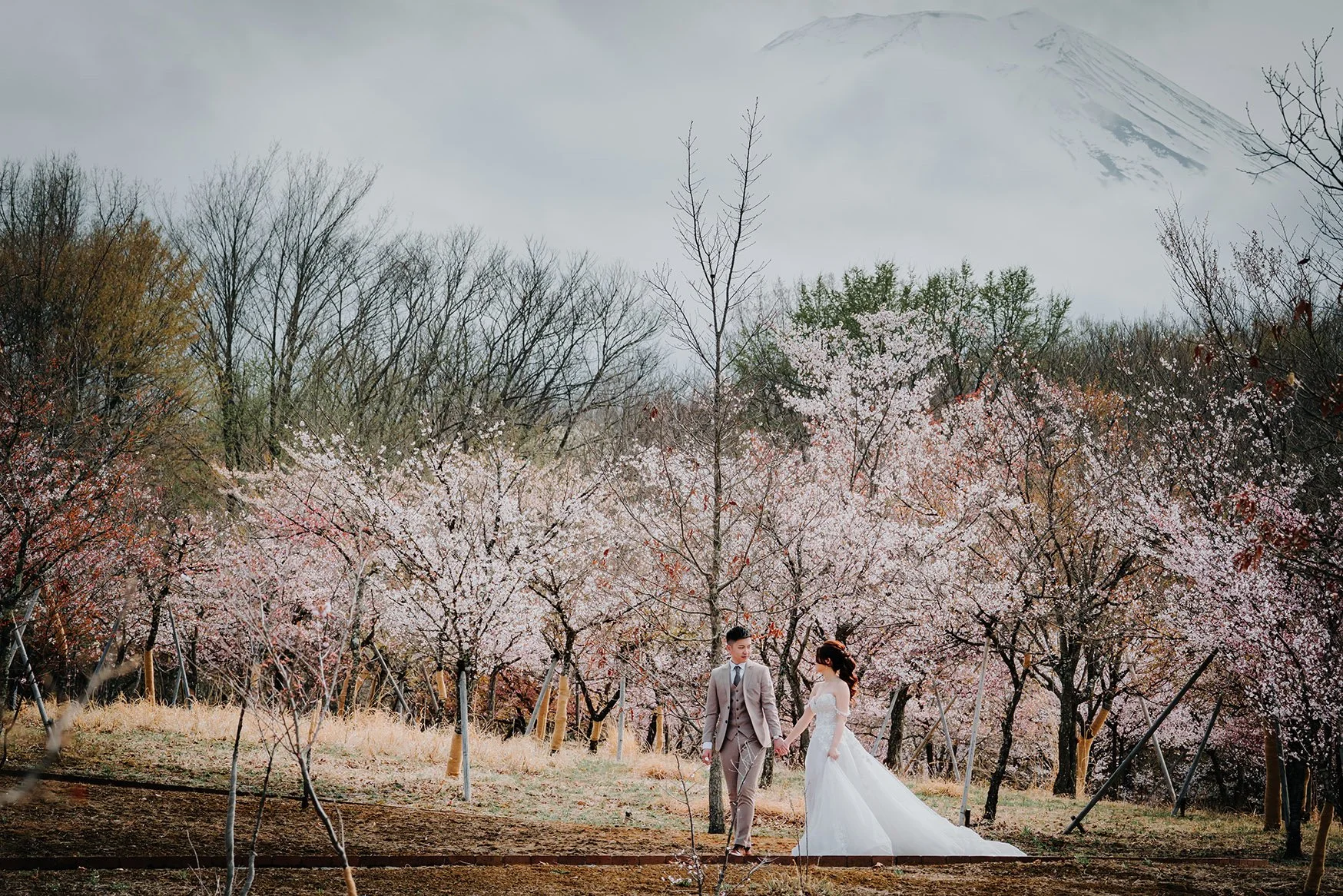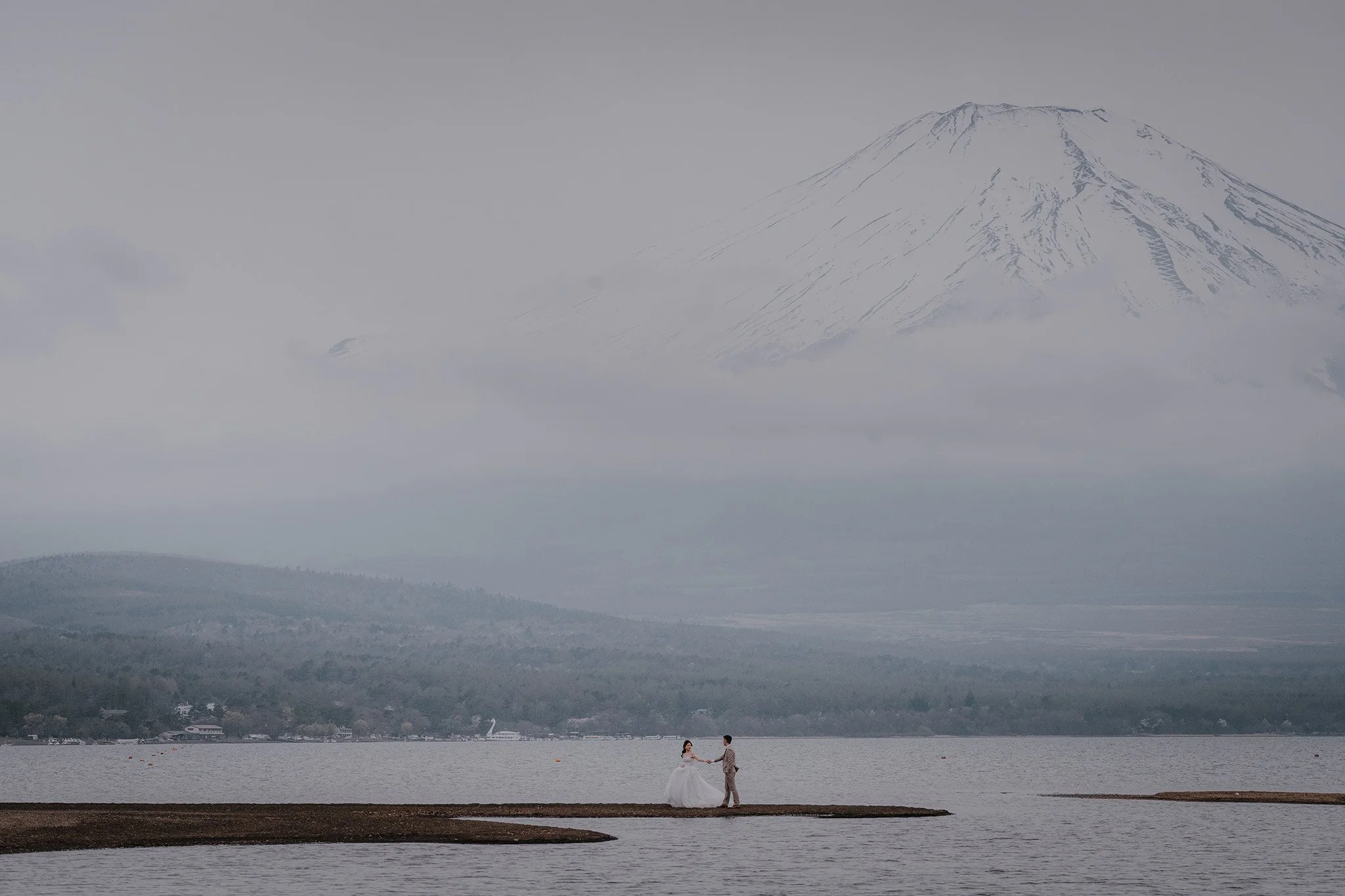Mt. Fuji Elopement & Pre-Wedding Photos: What You Need to Know
Mt. Fuji is one of the most breathtaking backdrops in Japan and a dream location for many couples planning a proposal, engagement shoot, pre-wedding photos, or even a romantic elopement. With its snow-capped peak, serene lakes, and surrounding landscapes, it’s no wonder Mt. Fuji is one of the most requested locations I photograph.
But to truly capture the magic of Fuji, timing and preparation are everything. Here’s what you need to know when planning your special day.
Best Season for Mt. Fuji Wedding & Elopement Photos
The most important factor in seeing Mt. Fuji clearly is the season.
Autumn (October–November): Crisp skies, beautiful autumn foliage, pampas grass, and the return of Fuji’s snowcap. My favorite season to photograph in the Mt. Fuji area.
Winter (December–February): The clearest season with the best chance of seeing the mountain unobstructed. Snow adds a unique atmosphere, and the mountain is always snow-capped.
Spring (April–May): Cherry blossoms bloom around Fuji’s lakes in April, offering the dream combination of sakura and Fuji. After cherry blossom season, other flowers like nemophila also make the scenery special.
Cherry blossoms & Mt. Fuji - this whole place was empty while other places were packed with tourists!
✨ Why not summer?
In summer (June–August) & September, Mt. Fuji is often hidden by clouds and haze. The hot and humid weather makes clear views rare, and the mountain frequently disappears behind thick clouds. Also, there is no snowcap during these months. Mt. Fuji looks much more impressive with its snowcap, which is why I only travel to the area from October through May.
Best Times of Day for a Mt. Fuji Photoshoot
When photographing Mt. Fuji, natural light makes all the difference.
Sunrise: The mountain glows with soft pastel tones, and there are fewer people around. The fog floating on the lake adds a magical touch. Perfect for intimate proposals.
Late Afternoon to Sunset: The golden hour brings warm light. For couples who want a mix of iconic shots and relaxed portraits, this is the ideal time.
💡 Tip: Midday light is usually too harsh. For that reason, I only shoot at sunrise or in the late afternoon to take advantage of the most beautiful natural light.
Extra Tips for Planning Your Fuji Photoshoot
Stay Overnight Instead of a Day Trip
While it’s possible to do a day trip from Tokyo, staying near Mt. Fuji gives you the flexibility to photograph at sunrise or sunset without rushing. Early mornings are usually the clearest, so booking accommodation in Kawaguchiko, Yamanakako, or Fujiyoshida is highly recommended.Kawaguchiko vs. Yamanakako & Other Lakes : Which Fuji lake is right for your shoot?
Most international visitors stay around Kawaguchiko, as it is the most accessible and offers many hotels, cafés, and sightseeing options. It is a beautiful lake with iconic views of Fuji, but it can get very busy during peak seasons like cherry blossoms and autumn foliage.
Mt. Fuji, however, has five lakes — Kawaguchiko, Yamanakako, Saiko, Shojiko, and Motosuko. Each has its own charm, and they all offer different angles of the mountain.
My personal favorite is Yamanakako, the closest lake to Mt. Fuji. It has fewer crowds compared to Kawaguchiko and wide, open views of the mountain that feel more peaceful. Considering other lakes is a great idea if you’re visiting during a busy season or want a quieter experience.
Pre-wedding photoshoot at Yamanakako with majestic Mt. Fuji
Consider Weekday Sessions
The Mt. Fuji area gets very busy on weekends, especially during cherry blossom and autumn foliage seasons. Plan your photoshoot for a weekday for a more relaxed atmosphere with fewer crowds.Temperature Differences
The Mt. Fuji area is much colder than Tokyo. Because of this, cherry blossoms bloom later here and autumn foliage appears earlier. So if you miss cherry blossom or autumn foliage season in Tokyo, you can still see them around Mt.Fuji area. Cherry blossoms usually bloom in mid–late April, and autumn foliage peaks in early-mid November in Mt. Fuji area.Know About Permits & Rules
Some locations around Fuji require special permits, particularly if you’re in wedding attire. Certain shrines, parks, and gardens need advance booking or have restrictions. I handle all location permits and also know hidden spots without crowds where we can capture beautiful views of Mt. Fuji.




